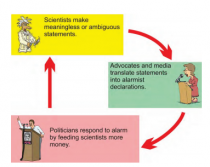by Senator Sessions
It has been eight years since the last major hurricane struck the United States - a lull that experts call an “extended and intense hurricane drought,” the longest such drought since reliable records began in the 19th century.
This is welcome news for Alabamians. The nation still remembers Hurricane Camille (a Category 5 storm) that hit our region in 1969. Hurricane Frederic (a Category 3 storm) made landfall at Dauphin Island in September 1979, leaving widespread devastation and a tree on the roof of my home in Mobile. Hurricane Opal (a Category 4 storm) struck Alabama in October 1995. And it doesn’t take a major hurricane to cause tremendous damage, as “Superstorm Sandy” demonstrated.
We face other forms of extreme weather too, like droughts, floods, and tornado outbreaks that can leave a wide path of destruction. Extreme weather happens, and we should all take common-sense, cost-effective steps to plan, prepare, and respond. The federal government has a key role to play there.
But the Obama Administration, congressional Democrats, and other climate alarmists are now pointing to extreme weather in a desperate attempt to promote their political agendas at the expense of hardworking Americans.
There is a reason for this dubious strategy: We are in the midst of a 16-year period without a measurable increase in global temperatures. It’s hard to sell voters on a trillion-dollar plan to fight global warming - already rejected by Congress - when the globe isn’t actually warming as much as they predicted. So the alarmists are increasingly citing extreme weather to convince Americans that we need a carbon tax, more job-killing regulations, and more wasteful federal green energy subsidies.
Al Gore recently asserted that “all weather events are now affected by global warming pollution.” Senator Barbara Boxer (D CA) called last year’s Superstorm Sandy “evidence of climate change mounting around us.” In his “Climate Action Plan,” President Obama contends that we are having more weather disasters than before. The facts disprove this argument.
The Senate Committee on Environment and Public Works, of which I am a member, recently held hearings about climate change and extreme weather. A clear finding of those hearings frustrated the alarmists: The frequency of extreme weather events is not increasing.
The testimony of Dr. Roger Pielke - a noted climate-impacts expert who even endorses the idea that global warming is partly caused by humans - was particularly compelling. Dr. Pielke testified: “It is misleading, and just plain incorrect, to claim that disasters associated with hurricanes, tornadoes, floods, or droughts have increased on climate timescales either in the United States or globally.”
He also said that it is “incorrect to associate the increasing costs of disasters with the emission of greenhouse gases.”
And Dr. Pielke provided data to back up his position:
Globally, “weather-related losses” have not increased since 1990.
In the U.S., hurricanes have not increased in frequency or intensity since at least 1900.
Since at least 1950, the intensity and frequency of floods in the U.S. have not increased.
The frequency and intensity of tornadoes have not increased since 1950.
Drought has not increased globally in half a century.
Dr. Roy Spencer of the University of Alabama-Huntsville also testified that “there is little or no observational evidence that severe weather of any type has worsened over the last 30, 50, or 100 years.”
And when climate alarmists made the unsubstantiated claim at a Senate hearing last year that we are experiencing more extreme temperatures, State Climatologist Dr. John Christy showed that there were, in fact, many more high temperature records set in previous decades, particularly the 1920s and 1930s, than we see today.
This is a serious matter. President Obama has asked the American people to accept higher energy prices, fewer jobs, and a lower standard of living to prevent storms, droughts, and other changes in climate. Senate Democrats are pushing for a tax on carbon emissions that will increase the cost of gasoline and electricity for every American.
When it comes to understanding and predicting the Earth’s climate, I believe we need to be more honest and humble. No one person knows everything about the future of the planet’s climate. Earth’s history has seen ice ages and warming periods long before modern technology came around. Meanwhile, many technological advances - like electricity and automobiles - have resulted in improved quality of life and lifespan for billions.
We certainly can’t say that any particular weather event is caused by human greenhouse gas emissions. Just five months ago, government experts were forecasting an “active or extremely active” hurricane season.
Good policy should be formed on the basis of rational, humble and fact-based judgments. It should improve, not degrade, the conditions for working Americans.
(Jeff Sessions of Mobile was first elected to the U.S. Senate in 1996.)
By Joseph D’Aleo
ENSO has an effect on annual temperatures in the US and globally. Major volcanism plays a role with multi year cooling with a lack of volcanism leading to warming.
El Ninos produce a global pop in temperatures and La Ninas a dip. The frequency, strength and duration of El Nino and La Nina varies with the Pacific Decadal Oscillation (PDO).
The positive PDO which favors more El Ninos bring global warming, the negative PDO more La Ninas cooling.
The Atlantic also has an effect (besides increasing Atlantic tropical activity and summer ice melt and winter high latitude blocking which brings more cold and snow to Eurasia and North America). The positive (warm) AMO leads to global warming and the negative state cooling.
See the step change with the AMO flip in 1995.
Both the AMO and PDO produce warming in their warm mode and cooling in their cold mode. Obviously when both are warm, the global temperatures should be warmest and when most negative, coldest.
You see a connection (all data with 11 point smoothing)?
For our friend John Neilson Gammon, Andrew Dessler and the other idealogues in the once great Texas A&M program, I present the Texas annual temperature (NCDC) versus the sum of the AMO and PDO (both standardized, which offsets the fact that the indices are determined in different ways). Both the AMO and PDO have the same tripole ocean anomaly pattern.
The AMO drives the drought frequency in the southern plains and Corn Belt with location determined by the PDO (McCabe etal 2004).
BTW, CO2 rose according to ESRL the whole time the temperatures in Texas, the US and globe rode the AMO/PDO roller coaster. Oh and about the sun, well the TSI suggests the sun may drive the AMO and that the AMO may start an early decline soon.
Carbon Dioxide is not Pollution
The Carbon Sense Coalition has accused those waging a war on carbon dioxide of being “anti-green”.
The Chairman of Carbon Sense, Mr Viv Forbes, said that carbon dioxide is the gas of life, feeding every green plant, producing food for every animal and in the process releasing oxygen, another gas of life, into the atmosphere.
A recent report on measuring global vegetation growth notes that data from remote sensing devices show significant increase in annual vegetation growth during the last three decades. They also report that CO2 fertilization is more important than climate variation in determining the magnitude of the vegetation growth. “The CO2 fertilization effect of the carbon dioxide emitted to the atmosphere by mankind’s burning of fossil fuels, such as coal, gas and oil, is beginning to assume its vaulted position of being a tremendous boon to the biosphere...”
Current levels of carbon dioxide are well below optimal levels for plants, so all true environmentalists should welcome any increase - all life would benefit if the carbon dioxide content in the atmosphere was triple current levels. The biosphere always flourishes during the recurring but short warm eras on Earth. Ice ages are the times of extinctions. As oceans warm, carbon dioxide is expelled and water evaporates. Warmth, and more moisture and carbon dioxide in the atmosphere provide ideal growing conditions for the green world.
Carbon dioxide in the atmosphere is replenished mainly from warming oceans but also from termites, volcanoes and exhaling animals, assisted by about a 3% contribution from burning carbon fuels. No rational person could define carbon dioxide as “pollution”. It is a harmless, non-toxic, colourless natural gas that is the essential food for all plants which then produce food and oxygen for all animals. Almost everything in coal was derived from plant material so burning it is no more dangerous than burning wood. Both will suffocate you if burnt in a confined space, but when dispersed in the vast atmosphere their emissions are beneficial plant fertilisers.
Naturally we should minimize real pollution of land, atmosphere and oceans. Everything that man does could be seen to create some “pollution”. But very little pollution comes from modern coal-burning power stations. Modern power stations have extensive filtration equipment which ensures that the exhaust gases are harmless natural gases already present in the atmosphere nitrogen, water vapour and carbon dioxide all essential to sustaining life on Earth.
The smogs of Asia are not caused by burning washed coal in modern power stations. They are caused by burning everything else, usually in dirty open fires. They burn cow dung, wood, cardboard, plastic, paper, recycled oil, tyres, dirty coal, kerosene, anything available that will cook food, provide warmth/light or deter mosquitoes. Forest fires in Indonesia, cremations in India and dust from the massive Gobi desert all add to Asian air pollution. As do old worn-out boilers, furnaces, engines and obsolete power stations which can spew unfiltered exhaust gases, ash, soot and unburnt fuel into the air.
These are what cause real air pollution. carbon dioxide does not.
Fifty years ago, the suffocating smogs of London and Pittsburgh were solved by:
* bans on open fires and dirty furnaces, plus
* clean coal-fired electricity, and
* clean-burning piped coal gas.
The same solution will banish most Asian smogs today.
Correlation, Causation or a Carbon Tax Con-Job?
If two things vary in parallel, that is a positive correlation. But it does not prove that one causes the other. For example, wet roads always occur when it rains. But wet roads do not cause rain. Three things are required to prove that rain always causes wet roads.
Firstly, no exceptions, roads must get wet every time it rains. They do.
Secondly, the cause must always come before the effect. Rain always comes before wet roads (apart from snow, floods, burst water-mains etc).
Thirdly, we need a credible explanation of the mechanism. We have it - rain is composed of falling drops of water, and the water wets the road.
The three conditions are satisfied - therefore rain does cause wet roads. The theory becomes a law.
Now, let’s look at the theory that carbon dioxide (CO2) controls global temperature.
Firstly, there is no consistent correlation - CO2 has risen consistently for the last century but global temperatures rise and fall, and the trend has been flat for over a decade. This absence of consistent correlation proves that CO2 is not the prime controller of global temperature.
Secondly, ice core data shows that temperature turning points occur long before reversals in atmospheric CO2 content. This evidence suggests that global temperature may control the CO2 carbon dioxide content of the atmosphere, rather than the reverse. And there is a proven mechanism to explain that - warming oceans expel CO2 and cooling oceans absorb it.
Thirdly, although the mechanism of carbon dioxide warming exists, it is progressively less effective as CO2 levels rise.
It is clear that CO2 fails all tests as the controller of global temperatures. Other factors such as solar cycles, clouds and oceans have much bigger impact. Thus the carbon dioxide theory of global warming is a carbon tax con-job.
The Last Word
The Big Dollars are against us. In the last issue of Carbon Sense, we advised that our cartoonist had not been paid, and we appealed for funds. Admittedly it was in small print, but two weeks passed without a dollar. Then we received one subscription for $500. We paid a miserly $250 to our cartoonist and $374 to our internet mail server, leaving a deficit of at least $124 for the month. In the same period the sacked Climate Commissioner, Tim Flannery, set up a new Climate Council to carry on his climate scare campaign and raised $1,000,000. Then we hear that green councils are finding ways to soak ratepayers to support the discredited Climate Commissioner. Soon we will find that all sorts of State and Local government bodies, Universities and other Qangos will be paying subscriptions to fund Flannery’s never-ending climate alarmism, thus frustrating the desire of the government and the voters that this waste of tax funds must stop.
Naturally national climate conferences will also be organised so that the Government Climate Industry can continue to have annual parties at our expense. We have a big job ahead. And the big dollars are against us.
See the full PDF newsletter with many hyperlinks to support the arguments here.
October 22 04:57 PM
In Memory of Peter R. Leavitt
June 29, 1931 - October 21, 2013
Peter “Pete” Leavitt of Newton Centre on Monday, October 21 at 82 years old following a long battle with cancer. Meteorologist, founder of WSI Corp., Patriots fan and pianist; possessed with endless intellectual curiosity. Pete was a close friend and a great man. A true intellect, Pete was a joy to speak to about almost any topic. But clearly Pete was one of the top meteorologists in the country.
Peter received one of the first degrees in Meteorology from M.I.T. in 1956. He served as Chairman and Chief Executive Officer of Weather Services Corporation and was also founder of the WSI Corporation in 1978. He was a recognized authority on worldwide weather and its impact on crops. Peter ensured that The Weather Channel got the data it needed by putting resources at our disposal and working with the NWS on formatting. His knowledge of history of instrumentation, of the workings of NWS and politics made him an invaluable consultant to Icecap and served on the board over the few years where we were a C3 corporation.
As John Coleman, TWC founder commented last night:
“OMG I am deeply saddened to read here of the death of Peter Leavitt. As Joe D’Aleo has noted he was a key player in the development of the computer data function, a key element, in building The Weather Channel. He was also a close consultant for me on my relationship with the AMS. I last saw him at the Climate Skeptics conference in New York 10 years. He was very warm and cordial, witty and very well informed on the issues. What a delight. He was the founder of WSI, the ultimate weather data computer company and a great private meteorology firm on every level. My deepest condolences to his family.”
Alan Galumbeck, IT Director at TWC at start-up remembers on a facebook post last night.:
“I remember our early meetings with Pete Leavitt. He put his best people on our start-up project and virtually dedicated them to us for at least nine months. This was at a time when WSI, the weather data company, was the little brother to WSC, the private forecast company. Pete saw to it that we got the WSI resources we needed, even, I suspect, ahead of WSC’s needs.”
Pete was a Certified Consultant Meteorologist. Pete was a Fellow of the American Meteorological Society and charter member of the National Council of Industrial Meteorologists. Peter Leavitt was a professional consultant to private companies world-wide and contemporary peer professionals. He served on several academic and government advisory committees of the National Weather Service, National Academy of Sciences, AMS, NCIM, etc.
Peter lived near Central Park in NYC for many years and was intimately familiar with the siting and changes over time. He and I did the analysis referred to here that we presented to the EPA and NOAA on their temperature assumptions. But Peter’s knowledge of music and politics and history and sport always made for made enlightening and lively conversations. He was a true intellect not an elitist who just thinks they are, of which there are, Peter would agree, too many.
I will miss talking with Peter. Rest in peace my friend.
In lieu of flowers, remembrances may be made to the Peter R. Leavitt Family Fund for GI Oncology Research at the Dana-Farber Cancer Institute, Boston.
--------------
Perspective from a weather forecaster
by Judith Curry
The answer is the fruit of my labor, not the object of it. Because of that, you’ll look for anything to come up with the correct answer, not just a predetermined one where your self-esteem depends on it. Joe Bastardi
The last two weekends, I have featured perspectives on the climate debate from:
an engineer (Mike Haseler)
a physicist (Pierre Darriulat)
This week I feature a perspective from a weather forecaster, Joe Bastardi, which was published in the Patriot Post. I’ve received permission from Joe Bastardi to reproduce this in full:
I would love to debate Dr. Michael Mann. He’s a professor at Pennsylvania State University, and I’m a Penn. State Grad (Meteo. 1978). Enough people know me, as well as him, so we could charge a modest admission, fill Eisenhower Auditorium at PSU, and give all the money back to the PSU meteorology department whom I still love dearly in spite of my outcast status on the anthropogenic global warming issue.
But Dr. Mann would probably want no part of debating me on the main drivers of weather and climate given I have no higher degrees. C’mon, a BS in meteorology from PSU against this:
Education: A.B. applied mathematics and physics (1989)
MS physics (1991)
MPhil physics (1991)
MPhil geology (1993)
PhD geology & geophysics (1998)
Alma mater: University of California, Berkeley, Yale University
This would be a blow out. What chance would I have?
Let me be clear: Dr. Mann’s resume, along with anyone who receives a PhD in the physical sciences, impresses me. I have read almost everything Dr. Mann has written and, because of that, I understand where he’s coming from. But there are things that are lacking if one is pursuing the right answer, and that’s the methodology one learns in putting together a forecast, as to how to weigh factors in determining what’s going to happen. One has to examine all of what his opponent has, not close his eyes to anything that might challenge his ideas.
For instance, while I’ve read almost everything Dr. Mann has written, how many times has he had hands on experience in making a forecast that has to verify? It’s laughable to think, as a private sector meteorologist whose livelihood depends on being right, that one can separate climate from weather. I realized a long time ago that being able to recognize current patterns from understanding the past (it was drilled into me by my father, a degreed meteorologist) was essential to making a good forecast. The fact many climatologists downplay the relationship, or say they’re different, shows me they don’t know what they’re talking about. In other words, I do what they do, but they don’t do what I do. I read what they write, but they won’t stop to look at the other side.
Perhaps it’s like something we sometimes see in sports, the curse of talent. Most of these people are very smart. I went to school with future PhDs and could see that in the classroom, they were like my wrestling coaches at PSU, guys that were great doing what came natural to them. However, my wrestling coach used to stress that when you’re used to having everything come to you, it’s very hard to change and step up your level. Consequently, you’ll get beat on your weakest point and what you don’t know, and that’s where the methodology in forecasting comes in to the climate debate.
You see, in what I do, one must weigh factors and decide which ones are most important. Additionally, one gets used to challenges that can never really be seen in research. How so? Suppose someone gives you a grant to study global warming. Can you come back and say, “My research says there’s no global warming”? You have been given a grant to produce a result; how can you possibly justify that result if it;s the result that would cost nothing to come up with in the first place?
In my line of work, getting paid (having clients) depends on the correct result. The client doesn’t say, “I want a cold winter, here’s the money, forecast it.” The client asks for a forecast that gives him an edge. If you are right, the client renews; if not, it’s bye bye. But there’s no up front money that looks for a set result. This means the forecaster does not care whether it’s warm or cold, just that he gets the right answer, whatever that may be. This is not the case in the AGW branch of academia. Research grants come with the cause du jour just try getting a grant to disprove global warming (actually, you don’t need one; it’s easy to refute it just by understanding what’s happened before).
That said, regarding the climate debate, what factors am I looking at to come up with my conclusion? To me, this is a big forecast, and the simple answer is: It’s hard to fathom that CO2 can cause anything beyond its assigned “boxed in” value to temperatures because of all that’s around it. It comes down to the sun, the oceans and stochastic events over a long period of time with action and reaction, versus a compound comprising .04% of the atmosphere and 1/100th of greenhouse gasses.
But unless you work every day in a situation where you are reminded you can be wrong, you don’t have appreciation for the methodology of challenge and response you need to be right!
Then there’s another big problem: What if you have all this knowledge, you’ve taken a stand on this, and it’s your whole life, how can you possibly be objective? The climate debate and past weather events are needed building blocks for my product. That product involves a challenge each day. In the case of a PhD on the AGW side, they believe the idea is the product. Destroy the idea, you destroy the product; destroy the product, you destroy the person. Therefore, it’s personal. Your whole life all the fawning students, the rock star status is all gone. I would hate to be in that position. Each day I get up, and there it is the weather challenging me. The answer is the fruit of my labor, not the object of it. Because of that, you’ll look for anything to come up with the correct answer, not just a predetermined one where your self-esteem depends on it.
So these giants of science have a fundamental problem, and it runs contrary to their nature. In the end, the very talent and brilliance of a lot of these people may be what blinds them to what it takes to truly pursue the truth.
JC comment: Bastardi raises a critical point, regarding the issue of forecasting as it relates to climate science. Until recently, the public and policy makers were content to consider projections of future climate that depended only on scenarios of future greenhouse emissions. Since the climate models and observations agreed during the last quarter of the 20th century as portrayed in highly confident attribution analyses, these scenario projections were treated by many as forecasts, including the IPCC, who expected a temperature increase of 0.2C/decade in the first few decades of the 21st century.
The growing divergence of climate model simulations and observations in the 21st century is leading to the growing realization among scientists, policy makers and the public that other factors are important in determining climate on decadal and multidecadal timescales. The IPCC dismisses this as unpredictable internal climate variability, unpredictable solar variability, unpredictable volcanic activity. Well, this is good enough only for scientists that are only interested in the CO2 impact on climate, but not for the public and policy makers (paying the bills for all this climate research) that want to know how the climate will actually evolve over the the 21st century.
Here is an analogy from my personal experience. My company CFAN started making hurricane forecasts in 2007 for a major oil company, who wanted advance knowledge (better than market and NOAA) of Gulf hurricane activity. We had devised a scheme that predicted the formation of hurricanes from African Easterly Waves, up to a week in advance. We had some major successes in our first season, notably our forecasts for Hurricane Dean and TS Erin (which I understand made them a lot of money in natural gas trading), but we completely failed (along with everybody else) to predict the formation Hurricane Humberto. Humberto formed near the Texas coast and rapidly intensified. This was not picked up by our prediction scheme, since Humberto did not form from an African Easterly Wave. Well, telling our clients that this kind of hurricane just isn’t predictable wasn’t going to be good enough for our clients. So we embarked on a research project to figure out what kind of predictability there was for this type of storm, and developed a probabilistic warning scheme with different scenarios for this type of storm.
The point is this: climate modelling needs to move towards actually predicting future climate variability change. The initialized decadal forecasts are a step in the right direction, but we need scenarios of future volcanic and solar activity as well (not to mention more research needed to figure out the sun-climate connections). Having climate modelers work on the seasonal climate forecast problem, and watching their forecasts fail to verify, would be invaluable experience for climate modelers making the productions runs for CMIP/IPCC.
And finally, a remark about Bastardi’s invitation to Mann to debate, which is captured in these tweets:
Michael E. Mann @MichaelEMann16 Oct
#JoeBastardi (http://www.desmogblog.com/joe-bastardi ) and #AnthonyWatts (http://sourcewatch.org/index.php?title=Anthony_Watts...): The best that #ClimateChange #Denial has to offer!
.
Joe Bastardi @BigJoeBastardi16 Oct
@MichaelEMann Anytime you would like to debate me and have proceeds go to PSU met, set it up. Eisenhower Auditorium will see who knows what
.
Rich Fraser @richmanwisco16 Oct
@BigJoeBastardi @MichaelEMann To debate Bastardi would be granting him the false balance that he craves but does not deserve.Retweeted by Michael E. Mann
.
Based upon Mann’s retweet, I don’t expect him to debate Bastardi. I note that if a Georgia Tech alumnus wanted to debate me or otherwise meet me, i would offer to go to lunch with them to discuss. In fact, in response to this article in the Georgia Tech Alumni magazine, I was invited to lunch by an alum to discuss climate change. There were 4 of us at lunch. Towards the end of the lunch, the alum admitted that the invite was intended as sort of an ambush, intended to trip me up as they presented all sorts of skeptical arguments. He said that they were delighted to have such an open and honest discussion about the issue, and that the learned a lot from talking with me. The following week, the School of Earth and Atmospheric Sciences received a check from the alum for $10K.
So I encourage Mann to at least meet with Bastardi to discuss. But imagine a public debate or discussion or Q&A between Mann and Bastardi. That would be an event I would pay to see (well I wouldn’t travel to Penn State, but I would pay to watch it on the internet). Since Mann has only joined the Penn State faculty within the last decade, there are generations of Meteorology alums who have not been exposed to his wisdom. He could hold a book signing etc. Sounds like this event could be a real winner for Penn State in terms of alumni relations and fund raising.
The winter snow season is off to a roaring start. A record fall snowstorm hit the Black Hills Friday and Saturday with up to 48 inches of snow at Deadwood and winds that reached 71 mph at Ellsworth AFB.
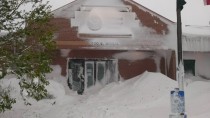
NWS at Rapid City
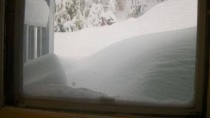
Deadwood, South Dakota
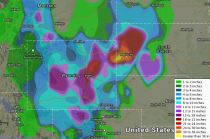
Lead, SD has 43.5 inches. Lead, SD gets an average of 197.5 inches of snow a year. But as for daily records, this will rank 4th largest on record behind 1973, 2006, 2008. It is the biggest early October storm since 1982.See the clean up in this storm chaser video.
The snow is increasing rapidly in North America and Asia. Running well ahead of last year. Recall that the arctic ice increased almost 60% over 2012.
More is forecast the next 10 days. (maps from weatherbell.com)
Another snowstorm is on the way further south in the Rockies and high central plains.
Some are trying to blame the snow and winter cold on the lack of arctic ice. Of course trying to blame the late winter and spring blizzards last year to the lack of ice that had returned by the previous October should raise a question in any truly objective mind.The early snows following the recovery to arctic ice and the coldest summer on record in the arctic according to DMI questions that theory. As you know we attribute the cold winters and increased hemispheric snows to the +AMO and negative PDO (with help from low solar and high latitude volcanos) in recent winters. The positive AMO favors a negative AO and NAO which delivers the cold and snow.
Joseph D’Aleo, CCM
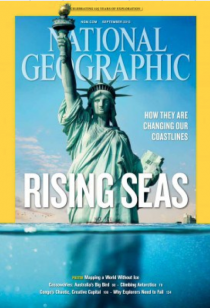
UPDATE: See a full scientific evisceration of the National Geographic story here by Dr. Don Easterbrook. See also Nils Axel Morner add to Don’s post here.
In the September 2013 issue of National Geographic, the feature story is on rising sea levels and how they are changing our coastlines. It shows a Statue of Liberty half submerged. The magazine in at least the past decade has adopted the failing climate change advocacy position prevalent in today’s mainstream media. It has become more science fiction than science fact. It is sad because it once was a very popular very balanced and informative trustworthy magazine. A lot of the hype on sea level rises including talk by Mayor Bloomberg of the need to spend $20 billion dollars to protect the city from rising seas and storms is based on faulty data.
The entire environmental movement is based on flawed theories and models. Whenever the data disagrees with the data they assume the data is wrong and adjust it to fit their projections.
The late, great Richard Feynman, a Cornell Physicist said about the scientific method that if data or experiments don’t support your theory no matter how beautiful it is or smart you are, the theory is wrong.
For example, global temperatures stopped warming close to 17 years ago and have cooled since 2002. This is while CO2 has increased over 11%. None of the climate change models used by the UN showed this hiatus. Claims of the warmest decade and very high ranking months and years are based entirely on our government manipulating climate data. In 1999 when NASA’s James Hansen observed relative to the US annual temperatures in the 20th century, that the 1930s was clearly the warmest decade and 1934 the warmest year, 1934 was a full 1.1F warmer than the spike in the super El Nino of 1998 in the NOAA’s/NASA’s prize US data set which adjusted for urban contamination.
That was inconvenient since their global data set that was not adjusted for urbanization was showing significant warming over the same period. NOAA in 2007 removed the urban adjustment and changed other processing steps. The result was now that 1998 became 0.2F warmer than 1934, a change of 1.3F. One data set that was not altered, the state all time record highs and lows, showed a very different story more like that depicted in 1999. 39 of the 50 all time state record highs occurred before 1960. The most, 23, occurred in the 1930s. More state record cold records than warm have been set since the 1940s.
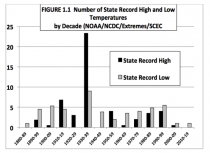
NOAA NCDC data compiled by Dr. John Christy for senate testimony in August 2012
The government loves to reinvent statistics. Does anyone really believe our real unemployment number is 7.3%? We get there by not counting people hopelessly unable to find employment. The CPI each month implies inflation is under control. But they exclude ‘volatile food and energy’. Sure boxer short prices are not rising at an alarming rate but gasoline is double what it was when Obama took office and a tank of heating oil may soon require a second mortgage. We shoppers all experience sticker shock when they go to buy package of chop meat. Sadly, this affects the poor and middle class the most as food and energy is what they spend the most money on. Europe went through this same green madness and is now abandoning it. That is not to say coproations don’t manipulate data when big money is involved - think Enron, MF Global, Bernie Madoff, and big pharma, but this is bigger and worse because it affects everyone.
But not the National Geographic, which had abdicated the once honest science for junk science advocacy. Let’s look at the facts.
Sea levels rise and fall as ocean temperatures rise and fall (causing expansion and contraction of the water) and as water is locked up in or increased in the major ice sheets in Antarctica and Greenland or during major glacial periods on the continents.
During the last glacial period, an ice sheet as much as 2 miles thick covered many parts of northern Europe and Asia and North America over Canada and the northern United States down to New York and south of Chicago. When the interglacial began and the ice retreated, meltwater caused a rapid sea level rise of 360 feet. In the last 8000 years sea level rise slowed to a crawl.
This figure shows sea level rise since the end of the last glacial episode based on data from Fleming et al. 1998, Fleming 2000, & Milne et al. 2005.
It likely varied with the cooling and warming periods that occur naturally. Global sea levels temporarily rise more when the ocean enter their warmer multidecadal phases and during major El Ninos and slow when the ocean basins cool and during major La Ninas.
Antarctica has been growing for 30 years, locking up more of the planet’s water in the icesheet. Greenland was 4C (8F) warmer than today’s level during the last interglacial without melting. With the Atlantic soon the head into its multidecadal cold mode and the sun into a 200 year slumber, cooling is likely to increase ice in Greenland. We already are seeing more snow in winter on land. 4 of the top 5 snowiest years for the hemisphere have occurred in the last 6 years.
Renowned oceanographic expert Nils-Axel Morner has studied sea level and its effects on coastal areas for some 45 years. Recently retired as director of the Paleogeophysics and Geodynamics Department at Stockholm University, Morner is past president (1999-2003) of the INQUA Commission on Sea Level Changes and Coastal Evolution, and leader of the Maldives Sea Level Project. In a 2010 paper in 21st Century Science and Technology Morner said
“While the IPCC and its boy scouts present wilder and wilder sea level predictions for the near future, the real observational facts demonstrate that sea level has remained virtually stable for the last 40-50 years.”
This is in sharp contrast with the model projections, similar to the way temperatures are defying the models.
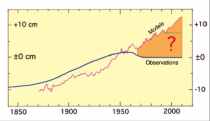
Morner (2011) Enlarged
TIDE GAUGES
Measurement sea level change at any location with tide gauges is complicated by the fact that the land is in many places sinking or rising. The mean of all the 159 NOAA tide gauge sites gives a rate of 0.5 mm/ year to 0.6 mm/year (Burton 2010). When you exclude those sites that represent uplifted and subsided areas, you are left with 68 sites of reasonable stability. These sites give a present rate of sea level rise in the order of 1.0 (+/- 1.0) mm/year (about 4 inches per century). Morner noted that most tide-gauges are installed on unstable harbor constructions or landing piers. Therefore, tide-gauge records are bound to exaggerate sea level rise.
A paper by Wenzel etal (2010) using a neural network on tide gauges found a mean sea level rise of 1.56 +/- 0.25 mm.yr from 1900 to 2006. They found the sea level changes are dominated by oscillations with periods of about 50-75 years, which relate nicely to the 60 year ocean oscillations.
SATELLITE ALTIMETRY
Satellite altimetry offers the reconstruction of sea level changes all over the ocean surface. The technology though has also produced disappointing results to the alarmist community as it has not shown the rise they expected.
The Topex/Poseidon and later Jason missions recorded the variations of the ocean surface with high resolution. Having applied all technical correction needed, Menard 2000 and also Aviso 2000) presented a linear trend of 1.0 mm/year from 1992 to 2000. However, the rise came mostly from a spike due to the ocean warming from a super El Nino in 1997/98. Eliminating that spike, gave as change of 0 +/- 10mm. This graph provides no indication of any rise over the time-period covered (Morner 2004, 2007a, 2007c).
Morner presented this trend analysis that treated the 1997 El Nino peak (yellow) as a separate event superimposed on the long term trend. This shows a stability over the first 5 years blue and possibly over the whole time period covered (from Morner 2004, 2007c).
The IPCC in 2007 was actually conservative (an average of 15 inches) with their projections compared with others who projected a change of 3 feet up to 20 feet or more. If you recall in the movie, an inconvenient truth Al Gore used a crane to demonstrate how high 20 feet was. It appears, he could have instead stood on the Manhattan phone book.
But even the IPCC played data games. The IPCC combined tide gauge and altimetry and to their alarm, showed no change. But they made an ‘adjustment’ to the data using the sea level change from one of four Hong Kong gauges. It was the only one that showed a sea level rise, indicating that the land was likely subsiding there. At the Moscow global warming meeting in 2005, in answer to Morner’s criticisms about this “correction,” one of the persons in the British IPCC delegation said, “We had to do so, otherwise there would not be any trend.”
Satellite altimetry data also shows no consistent upward trend and to resolve this dilemma, corrections were applied including corrections assuming that land is still rebounding from the retreat of the glaciers 10,500 years ago (glacial isostatic adjustment).
As with the surface temperatures, most all of the increases are in the adjustments.
So what does all this data suggest for the National Geographic scenario of a 200 foot rise?
Of course if the recent sea level rise has been 0 and it continues so, it will never reach the level depicted in the National Geographic. If it is Morner’s 1 mm/year, which the tide gauges, without accounting for the 1997/98 El Nino spike suggest, it would take 65,200 years. If the rise of 7 inches the last century repeats, it would take 36,629 years. If the mid range 15 inches predicted by the IPCC in AR4 remains in the Fifth assessment and were to verify, it would take 17,112 years.
Considering the fact we are already well past 10,000 years into the current interglacial and interglacials historically ranged from 10-15,000 years, under none of these scenarios would we ever see the Lady Liberty swimming. In fact we are more likely to be able to walk to the statue on a frozen sea/river or encased in ice.

Day after Tomorrow still
See more here.National_Geographicnm.pdf
“The IPCC has thrown down the gauntlet - if the pause continues beyond 15 years , they are toast.”
Judith Curry, professor and chair of the School of Earth and Atmospheric Sciences at the Georgia Institute of Technology
-------------------
Lord Christopher Monckton
SYDNEY, Australia It’s official. What I was howled down and banned for telling the recent U.N. climate conference in Doha is true. There has been no global warming for 17 years.
Rajendra Pachauri, the railroad engineer who heads the U.N.’s accident-prone climate panel, the IPCC, recently admitted this fact here in Australia.
The Hadley/CRU temperature record shows no warming for 18 or 19 years. RSS satellites show none for 23 years. Not one computer model predicted that.
Pachauri said the zero trend would have to persist for 30-40 years before it mattered. Scientists disagree. In 2008 the modelers wrote that more than 14 years without global warming would indicate a “discrepancy” between their predictions and reality. By their own criterion, they have grossly, persistently, profitably exaggerated manmade warming.
The 17-year flatline gives Australia’s $180,000-a-year, part-time climate kommissar, Tim Flannery, a problem. In January he crowed that extreme weather like Sydney’s recent heatwave had been predicted for decades.
Note Tim Flannery and his entire climate commission got their well deserved pinks slips after the election of Abbott.
Skeptics, he wailed, continued to ignore the thousands of hot-weather records tumbling worldwide. Yet without statistically significant warming for nigh on two decades, recent extreme weather cannot be blamed on global warming.
Warming that was predicted yesterday but has not happened for up to 23 years until today cannot have caused yesterday’s “droughts and flooding rains,” now, can it?
Flannery relentlessly gives only one side of the story when it is his duty to give both. He is carefully silent about the thousands of cold-weather records that have also tumbled in recent years more than 650 this week in the U.S. alone.
The Northern Hemisphere is enduring one of its coldest winters in 100 years. Before the usual suspects try to blame that too on global warming, the IPCC says unsurprisingly that warmer weather means less snow.
Sea-ice extent in the Arctic has reached a record high for this time of year, despite a record low last summer. In the Antarctic, sea ice has been increasing for 33 years.
There will be further extreme weather in the coming decades. It will not matter whether the world warms or cools. Extreme weather is not the new normal. It is the old normal but the new slogan.
The best-kept secret in climate science is that extreme weather, or “tipping points,” will be no likelier if the planet warms than if it cools. For the climate behaves as a chaotic object. What mathematicians call “bifurcation” can occur at any time.
We may warm the world this century, but not by much. What is important is not only the embarrassingly long absence of warming but also the large discrepancy between the rate of warming the models predict and the real-world rate.
The IPCC baselessly predicts 3 degrees Celsius manmade warming this century. The warming rate since 1950 has been a third of that. The maximum warming rate over any decade since 1850 was equivalent to less than 2 degrees per century.
No surprise, then, that the IPCC recently gave the lie to Flannery in a special report saying extreme weather cannot yet be attributed to manmade warming. Yet its own errors relentlessly exaggerate both manmade warming and its consequences.
In 1990 the first of its five reports said that from then till now the world would warm at 0.3 of a degree Celsius per decade. Outturn: less than half that.
In 1995 the scientists said five times there was no human influence on temperature and they did not know when it would become detectable. IPCC bureaucrats got a single bad scientist a one-man “consensus” to rewrite the report to say the flat opposite.
That year another bad scientist emailed a colleague: “We have to abolish the medieval warm period.” His problem was that the Middle Ages were warmer than now. Today’s temperatures are normal.
In 2001 the IPCC’s “hockey stick” graph duly “abolished” medieval warming. The shank showed little temperature change for 1000 years; the blade showed a sudden spurt in the 20th century, which the IPCC six times blamed on us. In 2005 two Canadian scientists proved the graph bogus.
In 2007 the IPCC doctored another graph to pretend manmade warming is accelerating. The Obama administration is using this faked diagram to justify introducing a carbon tax just as the EU/Oz tax collapses.
This year will bring a fifth “Assessment Report.” As an expert reviewer I shall try to halt further fraud. It will not be easy. The weevils are at it again. This year’s new predictions, backcast eight years to 2005, bizarrely overstate already measured warming and project the exaggerations to 2050, forecasting unrealistically rapid warming.
A senior Australian police officer specializing in organized-crime frauds tells me the pattern of fraud on the part of a handful of climate scientists may yet lead to prosecutions.
When the cell door slams on the first bad scientist, the rest will scuttle for cover. Only then will the climate scare mankind’s strangest and costliest intellectual aberration be truly over.
Read more.
Dr. Richard Lindzen
The issue of global warming (or climate change or weather disruption or whatever the current label is) is often put forward as a moral issue, but this does not change the need to pay attention to the science. Indeed, the latter is a crucial prelude to the former. The situation here may not be as complex as is sometimes suggested. Frequently the questions posed in public discussions are so reductionist as to be silly. Is it warming or not? Is CO2 increasing. Is climate changing? Is summer sea ice decreasing? Such questions actually disguise what are the real policy-relevant questions. These are inevitably quantitative rather than yes-no in character.
Though it would be difficult to speak of universal agreement over any aspect of the issue, it is nonetheless the case that there are many areas of agreement among most of the scientists on both sides of this issue. Such agreement hardly insures that these views are correct, but, for the moment, they are a reasonable starting point.
There is general agreement that there has been a relatively small and irregular increase in global mean temperature anomaly over the past couple of hundred years; by ‘relatively small’ I mean relative to the actual variability of this quantity at any given location or even region. There is also agreement that this quantity has not risen for the past 17 years or so. Over the past two centuries the warming has been less than 1C.
There is general agreement that climate is always changing. To be sure, climate is more than simply the global mean temperature anomaly.
There is agreement that there is a greenhouse effect, and that doubling CO2, in the absence of any feedbacks, will lead to warming on the order of 1C; this is generally felt to be unalarming and perhaps even beneficial. The issue of feedbacks is crucial. Alarm requires, at the least, that these feedbacks actually greatly amplify the impact of man’s contribution to greenhouse gases.
There is agreement that CO2 in the atmosphere is increasing, and that current levels are about 35% greater than pre-industrial levels; there is agreement that much of this increase is likely due to industrial emissions.
There is agreement that when combined with other increasing greenhouse gases (like methane, nitrous oxide, etc.), the total greenhouse forcing is about 80% of what one expects from a doubling of CO2. That is to say, we are effectively pretty close to a doubling of CO2 in terms of greenhouse impact.
While there is significant disagreement as to whether feedbacks will diminish or amplify the effect of CO2, there is virtually no disagreement that the impact of each added amount of CO2 diminishes relative to earlier amounts. This is referred to as the logarithmic regime.
There are two more points which I find substantial agreement over within the climate research community, but which might be contested by environmental activists:
Namely, that increases in CO2 will not jeopardize the planet, itself, and that any relation of increases in global mean temperature anomaly to such more relevant issues such as regional climate, storminess, extreme weather, etc. are not evident in the data nor are they robust features of models.
It is worth noting that none of the above point to alarm. Nevertheless, there has been a huge effort to implement mitigation policies. The presumed basis is essentially the precautionary principle. Despite the fact that there is no evidence for alarm, neither can it be rigorously rejected. The arguments for alarm are, moreover, frequently based on the misuse of scientific statements. For example, the IPCC iconic statement that there is 90% certainty that most of the warming of the past 50 years is due to man’s emissions. While one may legitimately question the subjective assignment of a probability to such a statement, the statement, itself, is again completely consistent with there being no problem. To say that most of a small change is due to man is hardly an argument for the likelihood of large changes.
Such misuse of language and logic bring to mind Orwell’s comment on the political implications of language: “It becomes ugly and inaccurate because our thoughts are foolish, but the slovenliness of our language makes it easier for us to have foolish thoughts.” As to political language, itself, Orwell notes that it “is designed to make lies sound truthful and murder respectable, and to give an appearance of solidity to pure wind.”
Turning to policy, there is widespread agreement that mitigation measures, such as the Kyoto Protocol, will have no discernible impact on climate regardless of one’s position on feedbacks.
Much more extreme measures will have no discernible impact on climate unless the most pessimistic and least supportable estimates of climate amplification are correct, and the proposed measures are universally adopted. All such measures, moreover, will have negative impacts on income, development, the environment, and food availability and cost especially for the poor. We know these impacts are real because we are already seeing them and have been doing so for some time. That these measures are endorsed by the environmental movement is hardly reassuring. The movement has racked up an impressive record of endorsing measures that have led to the death and debilitation of millions of the world’s most vulnerable. The complete banning of DDT and its impact on malaria is a notable but not unique example.
Under the circumstances, it would appear that the reasonable and moral policy would be to foster economic growth and well being in order that societies be better able to deal with climate change regardless of its origin. Mitigation policies appear to have the opposite effect without significantly reducing the hypothetical risk of any changes in climate. While reducing vulnerability to climate change is a worthy goal, blind support for mitigation measures regardless of the invalidity of the claims constitutes what might be called bankrupt morality. It is worse than bankruptcy when the proposed measures are counterproductive. It is not sufficient for actions to artificially fulfill people’s need for transcendent aspirations in order for the actions to be considered moral. PDF
----------
Every once in awhile a window opens and shows us the dark, illogical souls of the bureaucrats in the climate cabal. This is one of those times.
Regardless of whether or not scientists are wrong on global warming, the European Union is pursuing the correct energy policies even if they lead to higher prices, Europe’s climate commissioner has said.
There’s more.
Let’s say that science, some decades from now, said ‘we were wrong, it was not about climate’, would it not in any case have been good to do many of things you have to do in order to combat climate change?.
These are the views of the EU climate commissioner, Connie Hedegaard.
Read it all here
--------
Ross McKitrick Catches IPCC Contradicting Itself “in Full Denial Mode”
“The IPCC graph shows that climate models [that provided the foundation for its first four Assessment Reports] predicted temperatures should have responded by rising somewhere between about 0.2 and 0.9 degrees C [post-1990]. But the actual temperature change was only about 0.1 degrees, and was within the margin of error around zero. In other words, models significantly over-predicted the warming effect of CO2 emissions for the past 22 years,” wrote Dr. Ross McKitrick, an expert reviewer for the Intergovernmental Panel on Climate Change (IPCC), Associate Professor of Economics at the University of Guelph, Ontario, Canada, and a member of the Cornwall Alliance Advisory Board who has co-authored several of our major papers.
Writing in the Financial Post, he continued, “...Judging by the drafts [of its Fifth Assessment Report] circulated this year, [IPCC] is in full denial mode. Its own figure reveals a discrepancy between models and observations, yet its discussion says something entirely different. On page 9 of Chapter 1 it explains where the numbers come from, it talks about the various challenges faced by models, and then it sums up the graph as follows: ‘In summary, the globally-averaged surface temperatures are well within the uncertainty range of all previous IPCC projections, and generally are in the middle of the scenario ranges.’ Later, in Chapter 9, it states with ‘very high confidence’ that models can correctly simulate global surface temperature trends.
“The IPCC must take everybody for fools. Its own graph shows that observed temperatures are not within the uncertainty range of projections; [observed temperatures] have fallen below the bottom of the entire span [of projections].”
“As the gap between models and reality has grown wider, so has the number of mainstream scientists gingerly raising the possibility that climate models may soon need a bit of a re-think,” McKitrick wrote. “A recent study by some well-known German climate modelers put the probability that models can currently be reconciled with observations at less than 2%, and they said that if we see another five years without a large warming, the probability will drop to zero.
“What’s more, the U.K.’s main climate modeling lab just this summer revised its long-term weather forecasts to show it now expects there to be no warming for at least another five years. Ironically, if its model is right, it will have proven itself and all others like it to be fundamentally wrong.
“To those of us who have been following the climate debate for decades, the next few years will be electrifying. There is a high probability we will witness the crackup of one of the most influential scientific paradigms of the 20th century, and the implications for policy and global politics could be staggering.”
Note: See on Judith Curry’s site, this excellent review of recommendations on how policy relevant science should be conducted.
---------
Posted on September 14, 2013 by Anthony Watts
This post contains excerpts of a letter sent to staff at the Ecole polytechnique federale de Lausanne (EPFL, English: Swiss Federal Institute of Technology in Lausanne) is one of the two Swiss Federal Institutes of Technology and is located in Lausanne, Switzerland.
I wonder how many more letters like this we will see after AR5 is released.- Anthony
An Aspiring Scientist’s Frustration with Modern-Day Academia: A Resignation
Dear EPFL,
I am writing to state that, after four years of hard but enjoyable PhD work at this school, I am planning to quit my thesis in January, just a few months shy of completion. Originally, this was a letter that was intended only for my advisors. However, as I prepared to write it I realized that the message here may be pertinent to anyone involved in research across the entire EPFL, and so have extended its range just a bit.
---
While I could give a multitude of reasons for leaving my studies, some more concrete, others more abstract, the essential motivation stems from my personal conclusion that I’ve lost faith in today’s academia as being something that brings a positive benefit to the world/societies we live in. Rather, I’m starting to think of it as a big money vacuum that takes in grants and spits out nebulous results, fueled by people whose main concerns are not to advance knowledge and to effect positive change, though they may talk of such things, but to build their CVs and to propel/maintain their careers.
(1) Academia: It’s Not Science, It’s Business
I’m going to start with the supposition that the goal of “science” is to search for truth, to improve our understanding of the universe around us, and to somehow use this understanding to move the world towards a better tomorrow. At least, this is the propaganda that we’ve often been fed while still young, and this is generally the propaganda that universities that do research use to put themselves on lofty moral ground, to decorate their websites, and to recruit naive youngsters like myself.
(2) Academia: Work Hard, Young Padawan, So That One Day You Too May Manage!
I sometimes find it both funny and frightening that the majority of the world’s academic research is actually being done by people like me, who don’t even have a PhD degree. Many advisors, whom you would expect to truly be pushing science forward with their decades of experience, do surprisingly little and only appear to manage the PhD students...Rarely do I hear of advisors who actually go through their students’ work in full rigor and detail, with many apparently having adopted the “if it looks fine, we can submit it for publication” approach.
(3) Academia: The Backwards Mentality
A very saddening aspect of the whole academic system is the amount of self-deception that goes on, which is a “skill” that many new recruits are forced to master early on… or perish. As many PhD students don’t truly get to choose their research topic, they are forced to adopt what their advisors do and to do “something original” on it that could one day be turned into a thesis.
(4) Academia: Where Originality Will Hurt You
The good, healthy mentality would naturally be to work on research that we believe is important. Unfortunately, most such research is challenging and difficult to publish, and the current publish-or-perish system makes it difficult to put bread on the table while working on problems that require at least ten years of labor before you can report even the most preliminary results. Worse yet, the results may not be understood, which, in some cases, is tantamount to them being rejected by the academic community.
(5) Academia: The Black Hole of Bandwagon Research
Indeed, writing lots of papers of questionable value about a given popular topic seems to be a very good way to advance your academic career these days. The advantages are clear: there is no need to convince anyone that the topic is pertinent and you are very likely to be cited more since more people are likely to work on similar things. This will, in turn, raise your impact factor and will help to establish you as a credible researcher, regardless of whether your work is actually good/important or not.
(6) Academia: Statistics Galore!
“Professors with papers are like children,” a professor once told me. And, indeed, there seems to exist an unhealthy obsession among academics regarding their numbers of citations, impact factors, and numbers of publications. This leads to all sorts of nonsense, such as academics making “strategic citations”, writing “anonymous” peer reviews where they encourage the authors of the reviewed paper to cite their work, and gently trying to tell their colleagues about their recent work at conferences or other networking events or sometimes even trying to slip each other their papers with a “I’ll-read-yours-if-you-read-mine” wink and nod. No one, when asked if they care about their citations, will ever admit to it, and yet these same people will still know the numbers by heart. I admit that I’ve been there before, and hate myself for it.
(7) Academia: The Violent Land of Giant Egos
[He must be talking about Mannworld here -Anthony]
I often wonder if many people in academia come from insecure childhoods where they were never the strongest or the most popular among their peers, and, having studied more than their peers, are now out for revenge. I suspect that yes, since it is the only explanation I can give to explain why certain researchers attack, in the bad way, other researchers’ work. Perhaps the most common manifestation of this is via peer reviews, where these people abuse their anonymity to tell you, in no ambiguous terms, that you are an idiot and that your work isn’t worth a pile of dung. Occasionally, some have the gall to do the same during conferences, though I’ve yet to witness this latter manifestation personally.
(8) Academia: The Greatest Trick It Ever Pulled was Convincing the World That It was Necessary
Perhaps the most crucial, piercing question that the people in academia should ask themselves is this: “Are we really needed?” Year after year, the system takes in tons of money via all sorts of grants.
What’s bothersome, however, is how long a purely theoretical result can be milked for grants before the researchers decide to produce something practically useful. Worse yet, there often does not appear to be a strong urge for people in academia to go and apply their result, even when this becomes possible, which most likely stems from the fear of failure. you are morally comfortable researching your method as long as it works in theory, but nothing would hurt more than to try to apply it and to learn that it doesn’t work in reality. No one likes to publish papers which show how their method fails (although, from a scientific perspective, they’re obliged to).
read it all at Pascal Junod
By David Rose
See also the story in the Tucson Citizen
A chilly Arctic summer has left nearly a million more square miles of ocean covered with ice than at the same time last year, an increase of 60 per cent.
The rebound from 2012’s record low comes six years after the BBC reported that global warming would leave the Arctic ice-free in summer by 2013. Instead, days before the annual autumn re-freeze is due to begin, an unbroken ice sheet more than half the size of Europe already stretches from the Canadian islands to Russia’s northern shores.
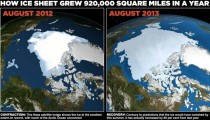
The Northwest Passage from the Atlantic to the Pacific has remained blocked by pack-ice all year. More than 20 yachts that had planned to sail it have been left ice-bound and a cruise ship attempting the route was forced to turn back.
Some eminent scientists now believe the world is heading for a period of cooling that will not end until the middle of this century, a process that would expose computer forecasts of imminent catastrophic warming as dangerously misleading.
The disclosure comes 11 months after The Mail on Sunday triggered intense political and scientific debate by revealing that global warming has ‘paused’ since the beginning of 1997, an event that the computer models used by climate experts failed to predict.
In March, this newspaper further revealed that temperatures are about to drop below the level that the models forecast with ‘90 per cent certainty’. The pause which has now been accepted as real by every major climate research centre is important, because the models’ predictions of ever-increasing global temperatures have made many of the world’s economies divert billions of pounds into ‘green’ measures to counter climate change. Those predictions now appear gravely flawed.
THERE WON’T BE ANY ICE AT ALL! HOW THE BBC PREDICTED CHAOS IN 2007
Only six years ago, the BBC reported that the Arctic would be ice-free in summer by 2013, citing a scientist in the US who claimed this was a ‘conservative’ forecast. Perhaps it was their confidence that led more than 20 yachts to try to sail the Northwest Passage from the Atlantic to the Pacific this summer. As of last week, all these vessels were stuck in the ice, some at the eastern end of the passage in Prince Regent Inlet, others further west at Cape Bathurst.

Shipping experts said the only way these vessels were likely to be freed was by the icebreakers of the Canadian coastguard. According to the official Canadian government website, the Northwest Passage has remained ice-bound and impassable all summer.
The BBC’s 2007 report quoted scientist Professor Wieslaw Maslowski, who based his views on super-computer models and the fact that ‘we use a high-resolution regional model for the Arctic Ocean and sea ice’.
He was confident his results were ‘much more realistic’ than other projections, which ‘underestimate the amount of heat delivered to the sea ice’. Also quoted was Cambridge University expert Professor Peter Wadhams. He backed Professor Maslowski, saying his model was ‘more efficient’ than others because it ‘takes account of processes that happen internally in the ice’. He added: ‘This is not a cycle; not just a fluctuation. In the end, it will all just melt away quite suddenly.’
The continuing furore caused by The Mail on Sunday’s revelations which will now be amplified by the return of the Arctic ice sheet has forced the UN’s climate change body to hold a crisis meeting. The UN Intergovernmental Panel on Climate Change (IPCC) was due in October to start publishing its Fifth Assessment Report a huge three-volume study issued every six or seven years. It will now hold a pre-summit in Stockholm later this month.
Leaked documents show that governments which support and finance the IPCC are demanding more than 1,500 changes to the report’s ‘summary for policymakers’. They say its current draft does not properly explain the pause.
At the heart of the row lie two questions: the extent to which temperatures will rise with carbon dioxide levels, as well as how much of the warming over the past 150 years, so far, just 0.8C, is down to human greenhouse gas emissions and how much is due to natural variability.
In its draft report, the IPCC says it is ‘95 per cent confident’ that global warming has been caused by humans’ up from 90 per cent in 2007. This claim is already hotly disputed. US climate expert Professor Judith Curry said last night: ‘In fact, the uncertainty is getting bigger. It’s now clear the models are way too sensitive to carbon dioxide. I cannot see any basis for the IPCC increasing its confidence level.’
She pointed to long-term cycles in ocean temperature, which have a huge influence on climate and suggest the world may be approaching a period similar to that from 1965 to 1975, when there was a clear cooling trend. This led some scientists at the time to forecast an imminent ice age.
Professor Anastasios Tsonis, of the University of Wisconsin, was one of the first to investigate the ocean cycles. He said: ‘We are already in a cooling trend, which I think will continue for the next 15 years at least. There is no doubt the warming of the 1980s and 1990s has stopped.
Then… NASA satelite images showing the spread of Artic sea ice 27th August 2012
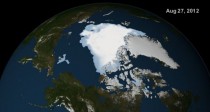
...And now, much bigger: The same Nasa image taken in 2013

‘The IPCC claims its models show a pause of 15 years can be expected. But that means that after only a very few years more, they will have to admit they are wrong.’
Others are more cautious. Dr Ed Hawkins, of Reading University, drew the graph published by The Mail on Sunday in March showing how far world temperatures have diverged from computer predictions. He admitted the cycles may have caused some of the recorded warming, but insisted that natural variability alone could not explain all of the temperature rise over the past 150 years.
Nonetheless, the belief that summer Arctic ice is about to disappear remains an IPCC tenet, frequently flung in the face of critics who point to the pause. Yet there is mounting evidence that Arctic ice levels are cyclical. Data uncovered by climate historians show that there was a massive melt in the 1920s and 1930s, followed by intense re-freezes that ended only in 1979, the year the IPCC says that shrinking began.
Professor Curry said the ice’s behaviour over the next five years would be crucial, both for understanding the climate and for future policy. ‘Arctic sea ice is the indicator to watch,’ she said.
UPDATE ON US CONGRESS from Myron Ebell
The House Republican leadership responded to our concerns very quickly once they started hearing from us and have pulled H. R. 1891 from the floor this afternoon. Many thanks to Speaker Boehner’s office and Majority Leader Cantor’s office. And again, many thanks to Larry Hart of the American Conservative Union for noticing that this obscure bill had been put on the suspension calendar. And thanks to all of you who responded with no notice. The House Republican Leadership had placed H. R. 1891, a bill sponsored by Representative Zoe Lofgren (D-Calif.), on the suspension calendar for Tuesday afternoon, 10th September. The bill would create the position of Science Laureate. If enacted, the President will be able to appoint up to three scientists each year to the honorary position of Science Laureate. This will allow this and future leftist presidents to put in positions of authority (without responsibility) and prominence activist scientists, who will then be able to use junk science to promote their political agendas. Think Paul Ehrlich, James Hansen, Peter Gleick, etc.
-------------
PRIME Minister-elect Tony Abbott has personally instructed his new departmental secretary to make preparations to axe the carbon tax and activate Operation Sovereign Borders to stop asylum boats.
Mr Abbott got down to business this morning after his landslide election victory, with a briefing with Department of Prime Minister and Cabinet Secretary Ian Watt.
Meetings were scheduled with Treasury secretary Martin Parkinson and Finance Department head David Tune, while Mr Abbott was also due to hold talks with senior Coalition colleagues later in the day.
He told Dr Watt to prepare the ground for the Coalition to implement its agenda swiftly, and he was confident the public’s “reasonable expectations” could be met.
“Obviously, a very early item of business is scrapping the carbon tax,” he told Dr Watt at the commencement of their meeting.
“There’s border security, there’s economic security and the people expect, quite rightly, that the incoming government will build a strong and prosperous economy for a safe and secure Australia.
“I deeply respect the professionalism in the Australian Public Service. You are experts at policy implementation and I’m confident that we will be able to successfully implement our agenda because that’s what people expect of us.”
As Labor enters a period of deep introspection over its future, Mr Abbott has also begun to field calls from world leaders, receiving a congratulatory call from UK Prime Minister David Cameron earlier this morning.
Voters last night delivered an emphatic verdict on six turbulent years of Labor rule, sending the party packing on the back of strong results in NSW, Tasmania and Victoria.
Mr Abbott has a packed agenda for his first 100 days in office. On the top of his agenda is rescinding the carbon tax.
But senior Labor figures have warned they are unlikely to recognise his claimed mandate to axe the measure, and are likely to frustrate the measure if the Senate numbers allow it.
Coalition finance spokesman Andrew Robb said the economy was in for a confidence jolt, declaring an Abbott government would “reboot” the mining boom and “massively” boost jobs.
--------
For more than a decade Australia had one of the world’s most successful center-right governments, and on Saturday it voted overwhelmingly for a restoration. After six years of Labor Party melodrama and leftward economic policies, Australians returned a Liberal government to power under new leader Tony Abbott. There are lessons here for conservatives in the U.S. and Europe. One lesson is to beware the faddish politics of climate change. Editorial, The Wall Street Journal, 9 September 2013
The World Wide Fund for Nature financed full-page adverts in Australian newspapers that awarded him a fail grade on every key environmental issue. Mr Abbott doesn’t care and neither, it seems, do Australian voters. In a decision that could not have been more different from Mr Cameron’s decision to mimic the environmental priorities of the Left, Mr Abbott has refused to accept inflated energy prices, fewer manufacturing jobs and higher carbon taxes as the price for not saving the planet. “Not” is the key word. Australia might be willing to bear sacrifices if global emissions were falling, but they aren’t. Unilateral action by nations such as Australia produces drop-in-the-ocean benefits if the likes of China and India continue to guzzle energy. Tim Montgomery,
Collapsing science, economies and international cooperation require that we refuse to act
Paul Driessen
The full-court press is on. Alarmist scientists, politicians, pressure groups, newspapers, ministers, rabbis and bureaucrats want Americans to “stop stalling” on climate change. They demand that we embrace “revenue-neutral” carbon taxes and carbon dioxide regulations, before it’s “too late” to prevent “catastrophic” global warming, “monster” storms and rising seas that will “inundate our coastal cities.”
Anyone dissenting from this “call to action” is a climate change “denier” a pejorative devised to vilify and silence anyone who rejects this agenda, by linking our views to Holocaust denial. What nonsense.
All of us “deniers” know climate change is real and has been throughout Earth’s many cycles of warming and cooling, storms and droughts, ice ages and little ice ages. Striations (scratches) on a chunk of Niagara Escarpment limestone that I dug out a mile from my boyhood home memorialize stones dragged by the last glacier that buried Wisconsin under a mile of ice. Countless climate changes have buffeted our Earth.
What we deny are assertions that human carbon dioxide emissions have replaced the myriad of complex, interrelated planetary, solar and cosmic forces that caused previous climate reverberations, and that what we are experiencing now is unprecedented and likely to be catastrophic.
Not one of the alarmist claims is supported by actual observations or scientific evidence. Even worse, the claims are getting more ridiculous with every passing day: “children aren’t going to know what snow is,” crime is rising, oceans won’t smell the same, and storms are getting worse because of global warming.
Contrary to the hype and hysteria, our planet stopped warming 16 years ago, even as atmospheric carbon dioxide levels continued to climb. That prompted climate catastrophists to start talking about “climate change” and blame every “extreme weather” event on CO2 emissions.
As I have pointed out before, far from being a “dangerous pollutant” (as President Obama and EPA keep saying), carbon dioxide makes all life on Earth possible. It makes food crops and other plants grow faster and better, loads them with more nutrients, helps them survive droughts, and makes our planet greener.
This trace gas has almost nothing to do with planetary warming or climate change. But it’s worth noting that the United States has slashed its CO2 emissions more than almost any other country - sending them back to where they were 30 years ago, thanks to the environmentalists’ latest target: fracking! And the daily human contribution of CO2 to our atmosphere is equivalent to a penny out of $1 million!
CO2 levels have “soared” to 400 ppm (0.04% of Earth’s atmosphere) not because of the USA or other developed countries but because China, India and dozens of other countries are working desperately to lift billions of people out of abject poverty. To do that, they need fossil fuels, which provide 80% of the energy that makes modern civilization and living standards possible and these countries are not going to slash their hydrocarbon use. To suggest otherwise reflects callous contempt for the needs of families that want to take their rightful places among Earth’s healthy and prosperous people.
No one would suggest that the absence of extreme weather events over a particular time period is due to humans. However, recent history certainly contradicts incessant claims that our weather is getting worse. In fact, no category 3 or higher hurricane has struck the United States in eight years, the longest such stretch since the Civil War. With only a couple of exceptions earlier this summer, the US is enjoying its longest respite from major tornadoes in decades. We are also witnessing the highest August Arctic sea ice extent since 2006, amid the coldest summer on record at the North Pole; record August lows for Alert and Eureka, in Nunavut, BC; and record highs for the extent of August sea ice in Antarctica.
Equally fascinating, most of the record high temperatures that the alarmists are trumpeting beat the previous records, mostly set in the 1930s, by mere hundredths of a degree. Yet, somehow that’s news. (if you only count stations with long histories extending back to the 1930s, the story is very different.
As to oceans inundating coastal communities, Topex Poseidon satellites show virtually no rise in sea levels between 1993 and 2001, and the EU’s Envisat satellites show no rise from 2003 through 2011. The steady 2 to 3 mm per year rise in sea level, it turns out, is because scientists “adjust” the raw data (always upward, never down, for some reason). But even 200-300 mm (8-12 inches) per century, or by the year 2100, is a far cry from the 3 to 20 feet that President Obama and former VP Al Gore have warned us about. Even Mr. Obama was off a few years when he said June 2008 was “the moment when the rise of the oceans began to slow.” But it’s one more climate cataclysm that we can erase from our worry list especially compared to the 400 feet that the world’s oceans have risen since the end of the last ice age.
(Mr. Gore is also famous for misinforming his 2009 “Tonight Show” audience that the Earth’s interior is “really hot, several million degrees” the core is actually 9,000 degrees F and for refusing to debate anyone on climate change or even take audience questions that he has not preapproved. Perhaps in his defense, Nobel Laureate Gore managed only a C+ and a D in the only science courses he ever took.)
If it’s “weird weather” you seek, just peruse Richard Keene’s fascinating weather guides, Skywatch East and Skywatch West, for numerous examples of wild and wacky weather in the USA. For more examples, check out the Tri-State Twister and Children’s Blizzard, or consult the Nongovernmental International Panel on Climate Change 2011 interim report, Climate Change Reconsidered. You will be amazed at how different the facts are from the fallacies, fibs and fear mongering you find in the “mainstream media.”
One final point. No tax that penalizes people and businesses for using fossil fuels is “revenue neutral.” Any such tax or regulation kills profits and jobs, turns full-time jobs into part-timers, and adversely affects people’s health and well-being. Millions of families cannot heat and cool their homes properly, pay their rent, mortgage or other bills, take vacations, or save for retirement. The increasing stress results in sleep deprivation, poor nutrition, more commuting, higher incidences of depression and alcohol, drug, spousal and child abuse, lower life expectancies and higher suicide rates. Climate taxes and regulations also force us to spend billions subsidizing environment unfriendly biofuel, wind and solar energy.
That’s an intolerably high price to pay, for “protection” from illusory and exaggerated climate dangers.
Climate alarmists are trying to sucker, snooker and stampede us into taking “immediate action” on job and economy strangling taxes and restrictions, before more people catch on to what’s really happening. This protection racket is one more example of passing a law, so that we can find out what’s in it. We simply cannot afford to let science continue being coopted to serve anti-hydrocarbon political agendas.
Demands that we “stop stalling” on “catastrophic manmade climate change” have nothing to do with preventing warming and cooling, storms and droughts that have been “real” since time immemorial. They have everything to do with regulating and restricting the use of hydrocarbons that provide 80% of the energy that makes modern civilization and living standards possible. They have everything to do with giving politicians, bureaucrats and pressure groups more money and more control over our lives and economy - but with no accountability for the lies, mistakes, job losses, ill health and deaths that are inevitable as US living standards deteriorate, and Third World lives remain destitute and desperate.
Computer models and scary predictions are not evidence. Basing energy and economic decisions on climate models is akin to betting your life’s savings on a computer model that focuses on middle linebackers and ignores quarterbacks and offensive lines, in predicting the Buffalo Bills will win the 2014 and 2015 Super Bowls and when the prediction falls flat insisting that the Bills really did win, and reality must be “adjusted” to make it conform with the predictions.
Climate “deniers” and rationalists should support Senator Ron Johnson (R-WI) and other politicians and scientists who are under constant attack by climate alarmists, for daring to dissent from approved orthodoxy. Their vigilance and determination are all that stand between energy and economic sanity and America heading down the same destructive path that Europe has trod for the past two decades.
Paul Driessen is senior policy analyst for the Committee For A Constructive Tomorrow (http://www.CFACT.org) and author of Eco-Imperialism: Green power - Black death.
By David Legates and Paul Driessen
ICECAP NOTE: See Paul’s book and many new entries in the Icecap Amazon Store. A lot of eye opening reading in the close to 90 books posted and available. Icecap gets a small percentage of the discounted prices to help us pay the bills and conduct the activities we do regionally and nationally in presentations, cable TV shows, interviews for TV and movies (coming soon) and in battling the EPA in the courts. As always your help with that and donations are always appreciated. The sad thing is that most all our efforts are pro bono while climate pretenders like Gore get $100,000 to do one presentation - no questions allowed and the alarmist spokesmen, professors and sites get thousands to millions in grants from the government (federal and state) and the Eco friendly funds.
The Department of Natural Resources and Environmental Control paid a professor from Texas named Dr. Katherine Hayhoe $46,000 to come up with a study on climate change and what was going to happen to Delaware if temperatures continued to rise and the oceans continued to flood the world. The state presumably wants people to think that “independent scholars” support the state’s positions.
The preliminary release of her report reads like the script from a bad disaster movie - think “The Day After Tomorrow” and “An Inconvenient Truth.”
It fails to mention the extreme cold that many places around the globe experienced recently. Europe and Russia in particular suffered through bitter cold the past two winters. The report likewise ignores that average global temperatures have not risen at all during the last 16 years; in fact, Earth has actually cooled slightly during the past decade.
For its really scary worst-case scenario, Dr. Hayhoe says Delaware’s temperatures will rise astronomically in coming decades: with more than two full months of endless days above 95 degrees Fahrenheit and a hundred-fold increase in days with temperatures at or above 100 degrees Fahrenheit by 2100. “Trends to more extreme highs and fewer extreme lows already are apparent,” Dr. Hayhoe asserts.
Data from 970 weather stations across the United States reveal that more record daily high air temperatures were set in the 1930s than in any recent decade, and no increase in frequency of higher temperatures has been observed since 1955. The Delaware State Climatologist examined New Castle County Airport records and found no long-term trend in either the total number of days or the number of consecutive days with maximum air temperature above 90 degrees Fahrenheit.
Globally, daytime high temperatures do not show significant warming - and most of the warming that has been observed is confined to nighttime low temperatures. Nighttime lows are driven by turbulence (or lack thereof) near the surface, not by the accumulation of energy related to CO2 warming of the deep atmosphere.
By contrast, maximum daily temperature is a measure of the energy content of the deep atmosphere, and is thus a much better measure of the warming due to greenhouse gases. The lack of a signal in maximum temperature suggests that the rate of warming due to CO2 is relatively small - and certainly much smaller than climate models suggest.
As for precipitation, Dr. Hayhoe claims that both floods and droughts will increase, with “more rain arriving as heavy downpours, and more dry periods in between.” This assertion was dispelled in a recent Intergovernmental Panel on Climate Change report on extreme events, released last summer.
The IPCC report concluded that “in some regions droughts have become less frequent, less intense or shorter; for example in central North America.” Similarly, the National Oceanographic and Atmospheric Administration has produced plots that show which parts of the United States are classified as moderate to extreme for dryness and wetness. While both conditions show considerable variability, neither exhibits a significant trend. NOAA also concludes that snowfall records show no long-term trend, and recent record snowfalls are the result of natural variability.
Why should Delaware’s or the nation’s future be any different than the past 50 years of increasing carbon dioxide concentrations? Dr. Hayhoe bases her extreme scenarios on climate models - the same models that have predicted major temperature trends that haven’t materialized; greatly exaggerated short-term trends in rainfall, droughts and violent storms; and failed to predict the lack of warming since 1998. Why should we believe them now?
Paul Driessen is senior policy analyst for the Committee For A Constructive Tomorrow (CFACT) and author of “Eco-Imperialism: Green power, black death” (Merril Press, 2012). David Legates is a professor of climatology at the University of Delaware and has studied climatology for more than 30 years. He is an adviser to the Caesar Rodney Institute.
James Taylor
Three “respected senior scientists” urged a colleague of Georgia Tech climate professor Judith Curry not to publish scientific findings because the findings would support skeptics of a global warming crisis. The revelation, which Curry reported yesterday on her climate science website, reveals global warming alarmists remain unashamed by the Climategate scandal and continue engaging in deception, deceit, and anti-science as a means to keep their fictitious global warming crisis alive.
Curry began her article by quoting the following hypothetical scenario from a science ethics article:
“Imagine the following scenario. An atmospheric scientist makes a discovery that seems to challenge a particular model of sea level increase due to global warming. She expects her discovery will be refined through further research, and that, in the end, it will not refute the mainstream view. In the meantime, she wants to avoid giving ammunition to climate skeptics, so she postpones publication.”
The author of the science ethics article gave an appalling opinion of what the scientist should do.
“The good cause which allegedly motivates much of the research puts the researcher in a special position. It allows them to dispense with essential standards of professional conduct,” the author wrote.
The real bomb in occurred Curry recounted a real-world experience that made the scientific ethics article seem downright tame.
“Last year, I encountered a stark example of this,” wrote Curry. “One of my colleagues was thinking about publishing a paper that challenges the IPCC interpretation of the previous pause during the 1940s to 1970′s. My colleague sent a .ppt presentation on this topic to three colleagues, each of whom is a very respected senior scientist and none of whom have been particularly vocal advocates on the subject of climate change (names are withheld to protect the guilty/innocent). Each of these scientists strongly encouraged my colleague NOT to publish this paper, since it would only provide fodder for the skeptics.”
The Scientific Method requires us to test and challenge our own theories. The Scientific Method requires us to not only test and challenge our own theories, but to encourage others to similarly challenge our theories. Instead, global warming alarmists. even those described as “respected” and not “particularly vocal advocates” on the issue, advocate suppressing scientific studies and hiding scientific evidence whenever it conflicts with their own speculative theories. The fact that all three “respected” and seemingly non-activist scientists sought to suppress scientific evidence is particularly damning to the alarmist cause.
Those people who pursue sound science respect and advocate critical inquiry and the Scientific Method. Those people who seek to suppress critical inquiry and scientific evidence engage in nothing short of anti-science.
The UN is 95% sure on AGW while unable to explain why there has been no warming over past 16 years
Hockey Schtick
According to Reuters, the new draft of the IPCC AR5 claims “it is at least 95 percent likely that human activities - chiefly the burning of fossil fuels - are the main cause of warming since the 1950s.” “That is up from at least 90 percent in the last report in 2007, 66 percent in 2001, and just over 50 in 1995.”
However, all of these fatuous figures are pulled `out of the air to support the IPCC ideologies and not based upon any statistical analysis or science. Meanwhile, they can’t explain why there has been no global warming over the past 16+ years:
An IPCC draft says there is “medium confidence” that the slowing of the rise is “due in roughly equal measure” to natural variations in the weather and to other factors affecting energy reaching the Earth’s surface.”
Scientists believe causes could include: greater-than-expected quantities of ash from volcanoes, which dims sunlight [there haven’t been any recent major eruptions]; a decline in heat from the sun during a current 11-year solar cycle [after claiming in past that such variations could not affect climate]; more heat being absorbed by the deep oceans [why wasn’t it absorbed at the same rate in the past?]; or the possibility that the climate may be less sensitive than expected to a build-up of carbon dioxide [now we’re talking!].
“It might be down to minor contributions that all add up,” said Gabriele Hegerl, a professor at Edinburgh University. Or maybe, scientists say, the latest decade is just a blip.”
-----------------------------------------------------------------------
Anthony Watts writes
Drafts seen by Reuters of the study by the U.N. panel of experts, due to be published next month, say it is at least 95 percent likely that human activities chiefly the burning of fossil fuels are the main cause of warming since the 1950s.
OK, so here’s the 64 thousand dollar questions for IPCC cheerleaders:
Which side is which time period?
What caused the warming before CO2 became an issue to be essentially identical to the period when it is claimed to be the main driver?
How is the IPCC 95% certain one side is caused by man and the other is not?
--------
The IPCC number in the last report was admitted to be one, chosen to prompt action by countries - supporting the UN agenda with funds and agreements. I’ll use their own words to show the motivation.
”The data doesn’t matter. We’re not basing our recommendations on the data. We’re basing them on the climate models.” Prof. Chris Folland, Hadley Centre for Climate Prediction and Research
“The models are convenient fictions that provide something very useful.” Dr David Frame, Climate modeler, Oxford University
Kevin Trenberth says “climatologists are nowhere near knowing where the energy goes or what the effect of clouds is. Says nowhere balancing the energy budget.”
Kevin Trenberth says they “can’t account for the lack of recent warming and that it is a travesty that they can’t.”
“None of the models used by IPCC are initialized to the observed state and none of the climate states in the models correspond even remotely to the current observed climate. In particular, the state of the oceans, sea ice, and soil moisture has no relationship to the observed state at any recent time in any of the IPCC models.” IPCC Lead Author Trenberth in Nature 2007 weblog. (Willie Soon “...garbage in, gospel out")
How are the models doing? Temperatures are tracking well below all scenarios including the one where CO2 holds steady. (It has risen close to 10% the last 16 years when temperatures stopped rising.
The models all have tropical warming- a hot spot in the upper troposphere and warmth to the oceans. It is not there in the data: balloon, satellite, buoy.
“It doesn’t matter what is true, it only matters what people believe is true.” Paul Watson, Co-founder of Greenpeace”
“Unless we announce disasters no one will listen.” Sir John Houghton, First chairman of the IPCC
“The only way to get our society to truly change is to frighten people with the possibility of a catastrophe” Emeritus Professor Daniel Botkin
Sea levels were forecast to rise 20 feet by AL Gore by 2100, 264 feet by James Hansen. They have slowed to less than 2 mm/year (4 to 6 inches per century).
Technology has been employed to try and assess how bad it is. When the technology shows no rises, they ‘adjust’ the output.
“We are on the verge of a global transformation. All we need is the right major crisis.” David Rockefeller, Club of Rome executive manager and Trustee of The Rockefeller Foundation a heavy funder of environmenal causes.
They tried heat waves, but records are ‘unadjusted’ unlike other trend data and tell the truth - US and global continental all time heat records.
Droughts and floods, show no trends.
In this year so far the tornado season is the quietest on record, looking back we don’t see an increasing trend (though in the cold PDO we may see more years like 2008 and 2011.
Global hurricane activity in coming off a 34 year minimum.
Yes Sandy did a lot of damage but it was because of where it hit and that it hit at high tide in a full moon. It made landfall as a bordeline CAT 1. 8 major hurricanes made east coast landfalls from 1938 to 1960.
Greenland is not warming and melting at an alarming rate. It has warmed as it did the last time the AMO was warm after cooling from the 1940s to middle 1990s.
And each successive millennial warming is cooler than the prior one. (Note: Ice core data is from Richard Alley PSU, no skeptic).
The arctic has seen more melt again due to the AMO but not unlike the middle 1900s and up from 2012 and several other recent years. Temperatures this summer are said to be the coldest in the record (DMI).
The Antarctic meanwhile is setting new records for ice extent.
Snow was supposed to be an increasingly rare event but has been setting records in both hemispheres.
Giorgio Filippo (University of Trieste) says that “The IPCC is not an assessment of published science but about production of results. Says there are very few rules and anything goes. Thinks this will undermine IPCC credibility. Says everyone seems to think it’s OK to do this.”
“This has almost nothing to do with environmental policy...one must say clearly that we redistribute de facto the world’s wealth by climate policy” Ottmar Edehoffer, UN IPCC
Most all of us follow sports. Before the season, if the team looks promising we may have relatively high confidence that the tam will have a good season and make the playoffs and maybe win it all. But often as the season progresses, we get disappointed. The team has a long losing stretch and is well behind the leaders. Our confidence in the teams chances drop. That is not how it works in today’s ‘science’. No matter how many bad forecasts and projections, the confidence that they are right keeps going up.
Here is the way it is supposed to work in science - Richard Feynman, famous Cornell Physicist





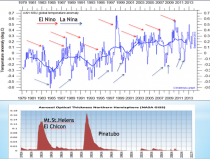

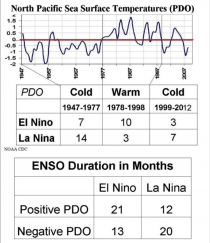
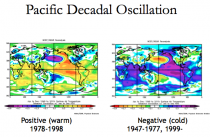
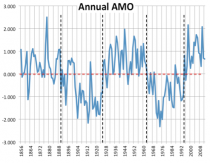
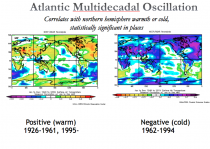
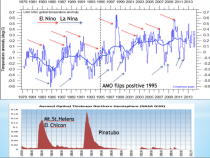
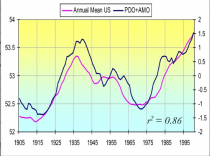
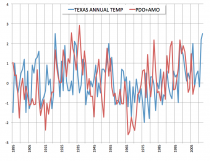


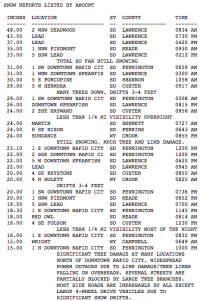


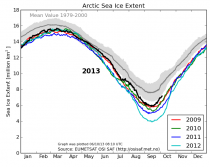
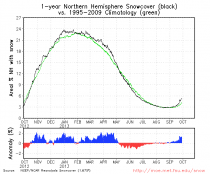
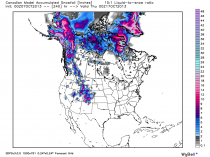
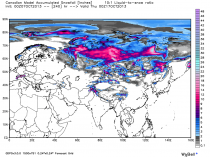
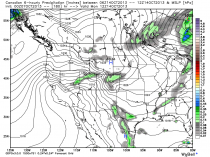
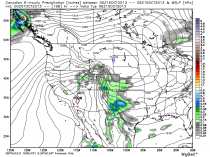
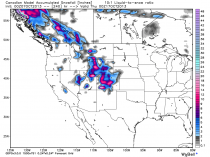

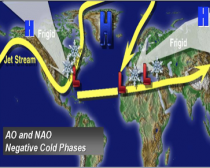
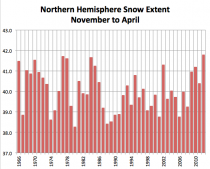
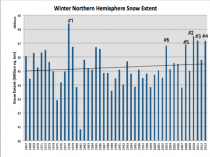
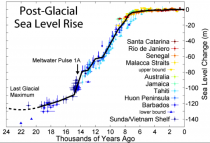

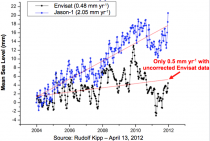
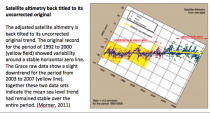
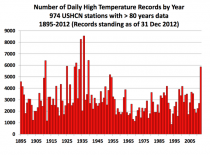
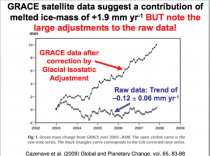
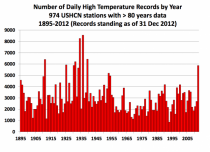
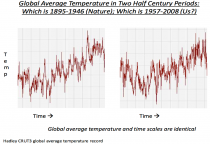
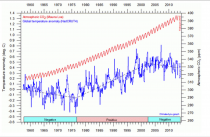
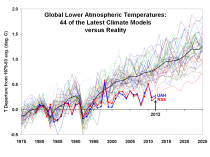
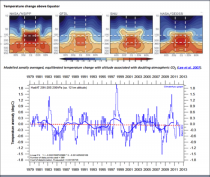

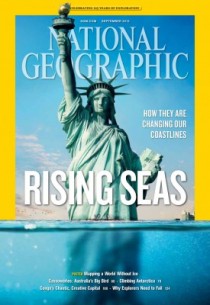
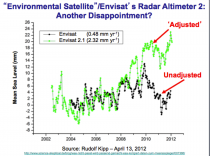

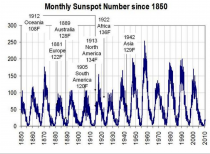

_thumb.png)
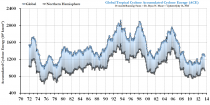
_thumb.png)
_thumb.png)

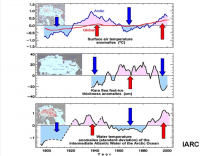

_thumb.png)
